3 things every high school coach should know about training the female athlete

3 things every high school coach should know about training the female athlete
The National Federation of State High School Associations estimates that there are approximately 3.4 million females who participated in high school sports during 2016-17. High school sports provides a myriad of physical, mental and social benefits for girls. But, female athletes also need to be physically prepared for the increased competitive demands of the sports.
Despite the recognized benefits of regular participation in a well-designed strength and conditioning program, including a reduced risk of ACL knee injury that is all too common in the female athlete, there are still many high school girls who do not participate in strength and conditioning programs. There may be several reasons for this observation including the oft-mentioned “ the weight room is for boys or ‘Football Only’”.
In this blog, a handful of strength and conditioning coaches with several years of experience in training the adolescent female athlete provide 3 things that every high school sports coach should know about training the female athlete. Collectively, there are several great points that include a good mix of advice about both “neck down” (physical) and “neck up” (mental and social) aspects of training the high school female athlete.
John Garrish | North Broward (FL) Prep
- Make it happen. The most important thing that I can say about training female student-athletes is first and foremost make it happen. Society still isn’t at a point that “training” as we know it is automatically and presumably comfortable for young women, especially under the watch of a person they previously thought was a football coach. Go out and reach them, meet them where they’re at and bring them in.
- Keep them engaged. Once you get a group of girls in the weight room, keep them engaged! Competitive games, calculated music playlists, intentional verbiage and undivided attention all go a long way in keeping young athletes interested.
- Shorter sessions. You’re better off keeping sessions short. Even if you don’t hit everything you’ve programmed, keeping it short and concise will keep it exciting. It’s better to miss an accessory tier of exercises than miss half of your girls the next day because they’re disinterested.
Karlyn Wilkes | Central Texas Christian School (formerly Texas Tech University)
- Teaching and training how to decelerate and cut and jump and land correctly will greatly reduce the risk of injury and increase performance. Learning how to control your body is one of the most important tools in sport that is not taught enough.
- Keep it super simple (KISS) and make sure that they get really good at the fundamentals – squat, hinge, single leg work, jumping and explosive movements, push, pull, and anti-rotation core. Make it as simple as you need to in order to get good technique, then make sure they push themselves and get really good at those things. There are a ton of fancy “sport specific” exercises and programs online, leave those for the top level (college, pro, olympic) athletes, not the high school kids. At the novice level, a basic program will make a kid stronger, faster, jump higher, etc. Just make sure they do it well.
- You can have the most perfect, athlete-specific program in the world, but if the kid is not working hard, it’s all for naught. Buy-in and good old-fashioned running and basic lifts as mentioned above will beat out “perfect” programming every day. Teach them to work hard and the rest will fall into place.
Adam Vogel | Bradley Bourbonnais (IL) High School
- They need to feel comfortable in the training environment including those that they are training alongside. They need assurance that they belong and that you believe in them. Spend a lot of time letting them know that the weight room is as much theirs as anyone else.
- Consider screening for knee valgus (knees come in) when jumping & landing by doing a jump test or mini-hurdle hop assessment. Also ask if they have scoliosis before axial loading (e.g., squat).
- Treat them fair. Stay away from cliches, each girl is an individual with their own strengths and areas that need addressed.
Wendy Glover | LEAP Athleadership Program, London, Ontario, Canada
- Understand what drives them as an athlete. Is it competition, friendship, belonging, etc.?
- Make sure that they understand that you care about them as a person first and athlete second, and that you are willing to build a trusting coach-athlete relationship with them.
- It is important to emphasize overall physical development that includes strength, power, speed and athletic movement for injury prevention and performance.
Todd Johnston | Kenowa Hills (MI) High School
- Strong does not mean bulky. You won’t be any less feminine if you lift weights.
- We aren’t “girls” – we are athletes!
- Heavy squats with great technique along with other posterior chain development (Glute Ham raises, deadlifts, single leg RDL, and lunge) are key for ACL prevention and athleticism.
John Radnor | Welsh Rowing and Cardiff Metropolitan University
- Teach them the benefits of resistance training to help build buy-in.
- Create an environment where they can support each other.
- Technique should be the main focus and feedback, not just outcome and personal records. Girls seem to focus on process rather than outcome.
Joe Sawicki | Shattuck St Mary’s
- Everything is done with the team in mind. Girls seldom work on their own. They can be unselfish – sometimes to a fault. They seldom want to be the strongest person in the room. Having the team progress equally is super important.
- To address point #1, competition adds great value. Girls do love to compete, even more so than the boys. Anytime you can add competition to a workout, you will see the entire group rise together.
- Physically, the biggest aspect I tend to work on most often is sprint mechanics. We achieve this with single leg strength, cross-body stability, and coordination. Weakness in these areas can results in muscle imbalances and ACL tears.
Doug Gle | Traverse City (MI) Central High School
- Treat them like athletes and don’t baby them. They can do more than they realize. You are doing them a disservice to expect less of them because of their gender.
- There are no male or female exercises. Any “female” specific exercise to help reduce the likelihood of injury for females will help male athletes too. I can’t think of an exercise that would help a female that wouldn’t also help a male and visa versa. The only thing I would add would pay attention to moreso in female athletes is valgus collapse (knees coming in) during the squat and lunge variations.
- If you can get the female athletes into the weight room, they will develop into some of your best technicians. They don’t usually come in with a false sense of confidence like adolescent male athletes often do. Because of this, they are usually more coachable and ask lots of questions. I often have to convince my female athletes that they are better and stronger than they realize.

